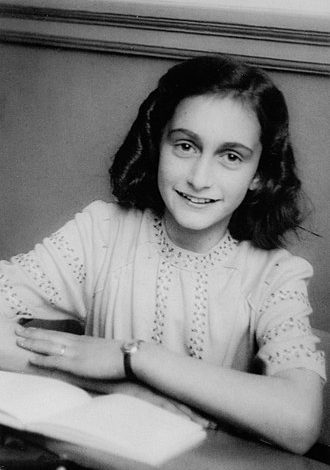Anne Frank

Annelies Marie “Anne” Frank (German pronunciation: [ˈanəˌliːs maˈʁiː ˈʔanə ˈfʁaŋk] (About this soundlisten), Dutch: [ˈɑnəˌlis maːˈri ˈʔɑnə ˈfrɑŋk]; 12 June 1929 – February or March 1945)[3] was a German-Dutch diarist of Jewish heritage. One of the most discussed Jewish victims of the Holocaust, she gained fame posthumously with the 1947 publication of The Diary of a Young Girl (originally Het Achterhuis in Dutch; English: The Secret Annex), in which she documents her life in hiding from 1942 to 1944, during the German occupation of the Netherlands in World War II. It is one of the world’s best-known books and has been the basis for several plays and films.
Born in Frankfurt, Germany, she lived most of her life in or near Amsterdam, Netherlands, having moved there with her family at the age of four and a half when Adolf Hitler and the Nazi Party gained control over Germany. Born a German national, she lost her citizenship in 1941 and thus became stateless. By May 1940, the Franks were trapped in Amsterdam by the German occupation of the Netherlands. As persecutions of the Jewish population increased in July 1942, the Franks went into hiding in some concealed rooms behind a bookcase in the building where Anne’s father, Otto Frank, worked. From then until the family’s arrest by the Gestapo in August 1944, she kept a diary she had received as a birthday present, and wrote in it regularly. Following their arrest, the Franks were transported to concentration camps. On November 1 1944[4], Anne and her sister, Margot, were transferred from Auschwitz to Bergen-Belsen concentration camp, where they died (probably of typhus) a few months later. They were originally estimated by the Red Cross to have died in March, with Dutch authorities setting 31 March as their official date of death, but research by the Anne Frank House in 2015 suggests it is more likely that they died in February.[3]
Otto, the only survivor of the Frank family, returned to Amsterdam after the war to find that her diary had been saved by his secretary, Miep Gies, and his efforts led to its publication in 1947. It was translated from its original Dutch version and first published in English in 1952 as The Diary of a Young Girl, and has since been translated into over 70 languages.
Frank was born Annelies[1] or Anneliese[2] Marie Frank on 12 June 1929 at the Maingau Red Cross Clinic[5] in Frankfurt, Germany, to Edith (née Holländer) and Otto Heinrich Frank. She had an older sister, Margot.[6] The Franks were liberal Jews, and did not observe all of the customs and traditions of Judaism.[7] They lived in an assimilated community of Jewish and non-Jewish citizens of various religions. Edith and Otto were devoted parents, who were interested in scholarly pursuits and had an extensive library; both parents encouraged the children to read.[8][9] At the time of Anne’s birth the family lived in a house at Marbachweg 307 in Frankfurt-Dornbusch, where they rented two floors. In 1931 the family moved to Ganghoferstrasse 24 in a fashionable liberal area of Dornbusch called the Dichterviertel (Poets’ Quarter). Both houses still exist.[10]
Anne Frank’s birthplace, the Maingau Red Cross Clinic
A four-story, brick apartment block showing the building’s facade, with several windows and an internal staircase leading into the block.
The apartment block on the Merwedeplein where Anne Frank lived from 1934 until 1942
In 1933, after Adolf Hitler’s Nazi Party won the federal election and Adolf Hitler was appointed Chancellor of the Reich, Edith Frank and the children went to stay with Edith’s mother Rosa in Aachen. Otto Frank remained in Frankfurt, but after receiving an offer to start a company in Amsterdam, he moved there to organize the business and to arrange accommodations for his family.[11] He began working at the Opekta Works, a company that sold the fruit extract pectin. Edith travelled back and forth between Aachen and Amsterdam and found an apartment on the Merwedeplein (Merwede Square) in the Rivierenbuurt neighbourhood of Amsterdam, where more Jewish-German refugees settled.[12] In late December 1933, Edith followed her husband together with Margot. Anne stayed with her grandmother until February, when the family was reunited in the Netherlands.[13] The Franks were among 300,000 Jews who fled Germany between 1933 and 1939.[14]
